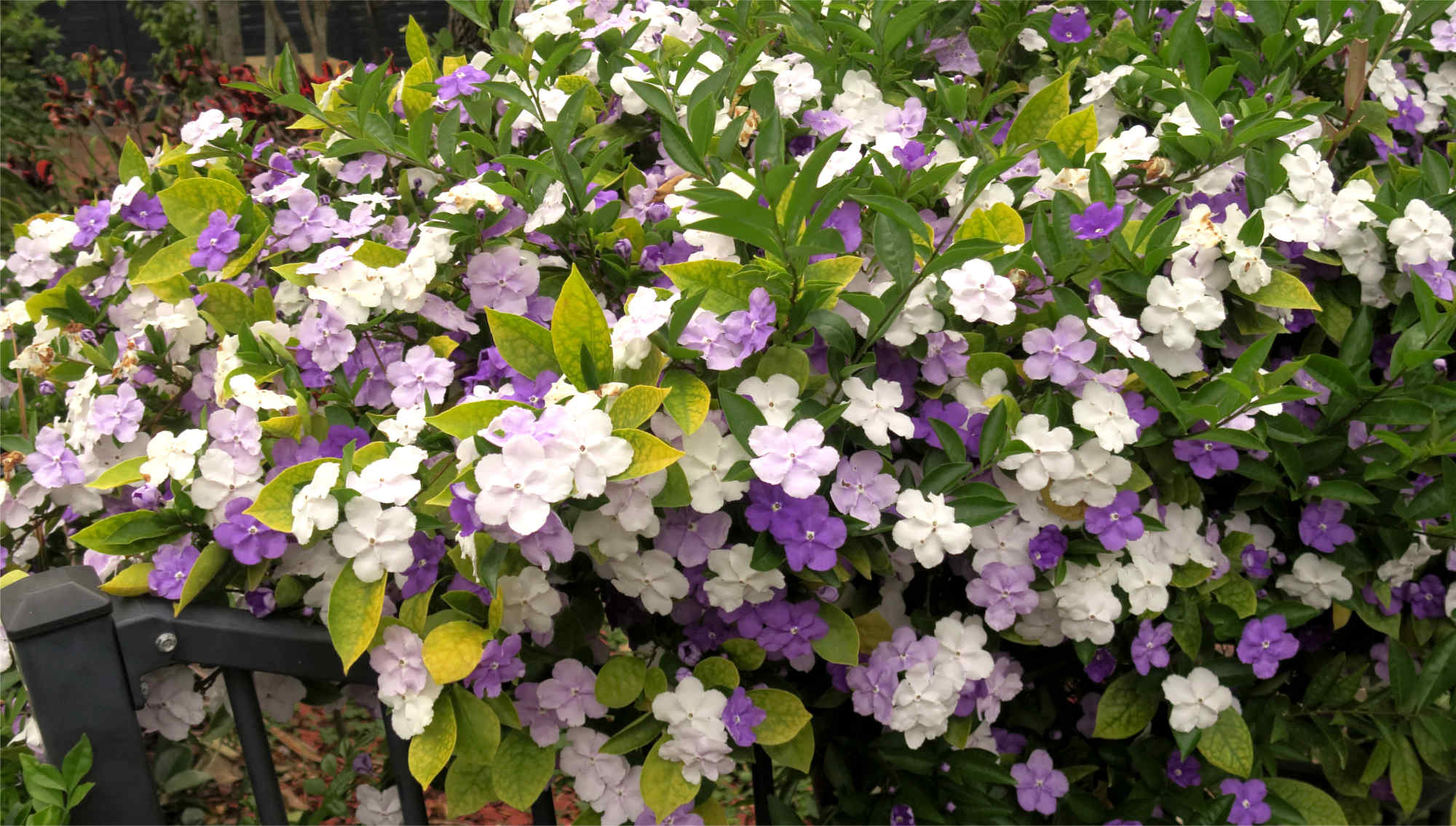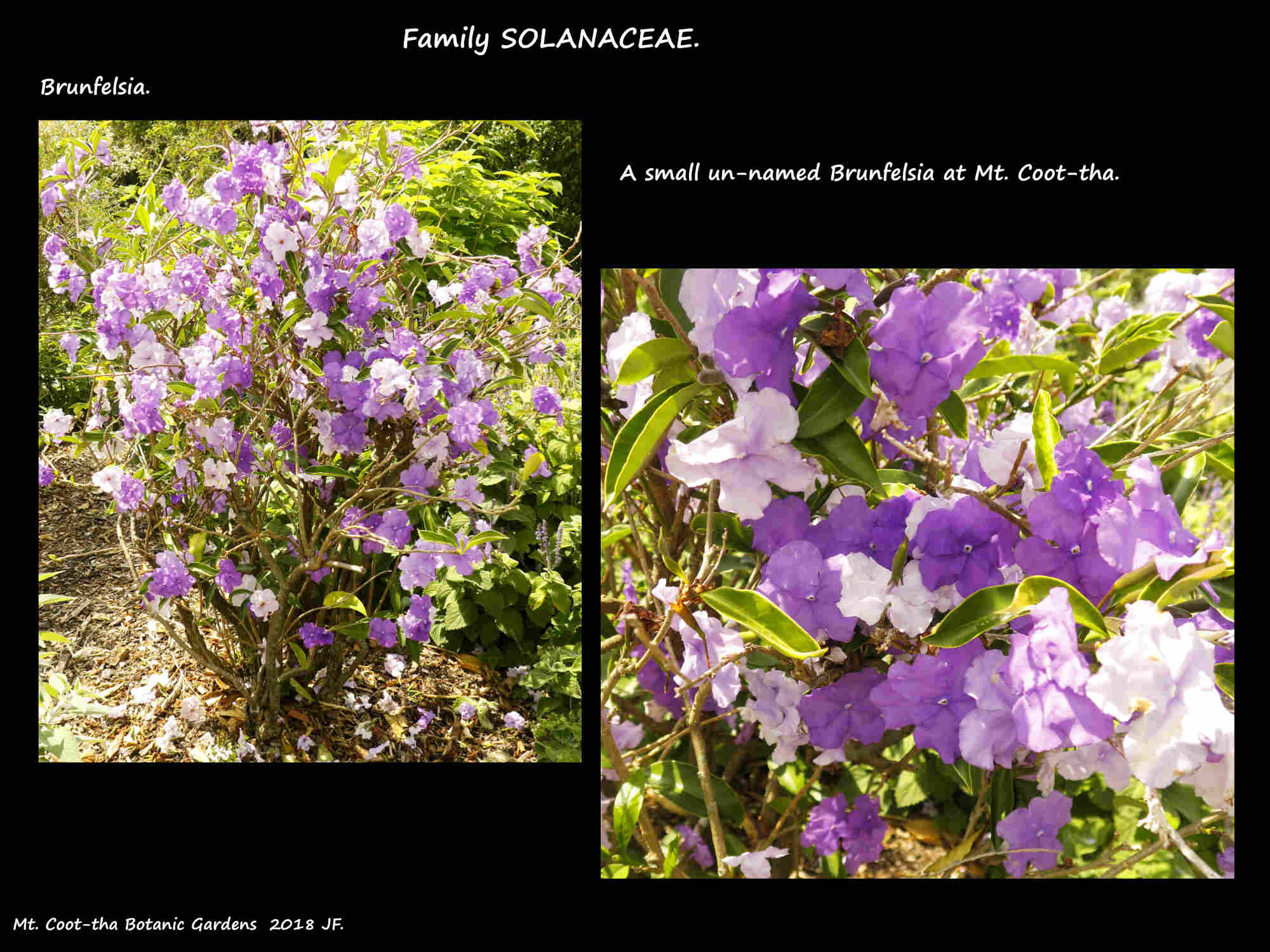Brunfelsia.
In Family Solanaceae > Subfamily Petunioideae it was previously known as the Franciscea genus.
There are around 45 species (25 to 49) a number of which are widely cultivated.
Most readily available from Australian nurseries are B. latifolia (B. australis), B. americana,
B. pauciflora and B. undulata.
More difficult to find are B. jamaicensis, B. grandiflora, B. lactea, B. maliformis and B. uniflora.
Cultivars available include B. latifolia ‘Compacta’ and ‘Compacta variegated’, B. undulata ‘White Caps’
and B. australis ‘Sweet & petite’.
B. australis and B. grandiflora share the common name ‘Yesterday, today and tomorrow’ because their
flowers open a dark purple, mauve or blue, fade to paler mauve or blue then become white over 3 days.
Brunfelsia are mostly dense evergreen shrubs from 0.2 to 2 or 3 m high.
There are some small trees up to 5 or 10 m high.
The tropical plants are evergreen but in colder climates some are semi-deciduous.
They may sucker from the roots and many branch strongly near the base.
Young stems are green or pale brown and older ones woody with grey-brown bark.
There may be longitudinal cracks in the bark.
The branches are slender and may be upright or arch over.
Young twigs, leaves and inflorescences mostly have sparse hairs when young.
Hairs may be simple or branched and many are glandular.
Those on the twigs and leaves tend to disappear with age.
The simple, often glossy leaves are alternately arranged.
They may be spread out along the branches, clustered at the branch ends or be on short side branches.
Most are light to dark green on the upper surface and paler underneath.
Even on a single plant the leaves vary greatly in size and shape.
Petioles, from 1 to 12 mm long may be smooth or sparsely to densely hairy.
The membranous or leathery blades are from 2 to 16 cm long and 1 to 6.5 cm wide.
They are commonly elliptic, ovate or obovate but occasionally oblong or lanceolate.
The base is mostly wedge-shaped and may extend down the sides of the petiole.
The tip is frequently a short point but may be a longer tapering one or rounded.
More rarely it is notched or has a mucro (a short, abrupt point).
The upper blade surface usually has no hairs.
The lower surface may be sparsely, or occasionally, densely hairy.
The simple or glandular hairs are concentrated on the midrib, along the veins and sometimes the edge.
Inflorescences are mostly terminal on the main branch or short side shoots but can be axillary.
They frequently consist of a solitary flower but there can be up to 10 or 20.
Even when solitary the flowers are prolific and cover much of the shrub.
Where peduncles are present they are from 1 to 6 (20 to 30) mm long.
Individual flowers may have no pedicel or one 2 to 8 (15) mm long.
The peduncle and pedicels may have simple or glandular hairs.
Some species have 1 to 3 leaf-like bracts 1 to 10 mm long at the base of the flower.
They may be narrowly lanceolate or obovate and frequently have hairs.
The green cup, bell or tubular calyx can be up to around 3 cm long and 1 cm wide.
The 5 lobes can be a few mms long or up to half the length of the calyx.
The triangular to ovate lobes have a pointed tip and may have glandular hairs.
The corolla is salverform with a long thin tube that changes abruptly into a flat spreading limb.
The tube, up to 5 cm long and 1 to 5 mm wide may have a few glandular hairs near the top externally.
The limb, of 5 roughly equal lobes is from 3 to 6.5 cm across.
The lobe bases overlap, the tips are rounded and they may be crenate or occasionally notched.
The throat is a few mms wide and around it, at the junction of the tube and limb is a corona or crown.
This is a circular, raised, whitish ring with glandular hairs on the outer side.
It is 3 to 4 mms wide, about 1 mm high and is thicker and more rigid than the lobes.
Most flowers open a purple, mauve, violet or bluish-mauve with a white or yellow throat.
They fade over a few days to pale mauve or blue then to white so there is a mix of colours on the shrub.
The change in colour is caused by a reduction in anthocyanin due to a change in acidity.
A few species have pale yellow flowers.
There are 4 stamens in 2 pairs of unequal length.
They are inserted onto the upper part of the corolla tube and do not extend past it.
The filaments of the upper pair are free for 1.5 to 6 mm and the lower pair for 2 to 3 (1 to 10) mm.
Below this they fuse with, and form ridges down, the tube.
The brown or greenish-brown anthers, 2 to 3 mm long are circular to kidney-shaped.
There is a smooth nectiferous disc around the base of the ovary.
Many flowers are most strongly scented at night to attract their moth pollinators.
Others are visited during the day by hummingbirds and bees.
The superior pale to bright green, ovate to conical ovary is 2 to 3 mm high.
It has 2 locules and the numerous ovules have axile placentation.
There is a single thin apical style that extends to the top of the corolla tube.
It can be 25 to 50 mm long, white or mauve and may be bent at the top.
It is thickened near the top where it divides into 2 unequal lobes.
The stigma is a 1 to 2 mm, pale green saddle-shaped area between the lobes.
It, and the upper pair of anthers are often visible in the throat.
Many fruit are capsules surrounded by the persistent calyx which splits down one or 2 sides.
The hairless capsules are roughly spherical to ovate and green, yellowish, orange or brown.
Their size ranges from 7 to 20 mm long and 2 to 20 mm wide.
Some fruit are fleshy and indehiscent.
There may be 10 to 30 dark brown, black or reddish-brown seeds.
The often angled seeds are 3 to 6 mm long and 2 to 6 mm across.
There are a number of hybrids and cultivars including dwarfs, more compact shrubs and some with larger
flowers or variegated leaves.
J.F.



